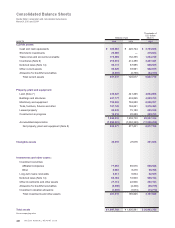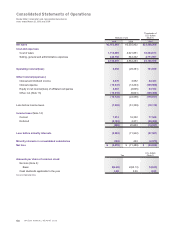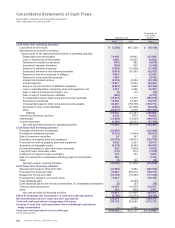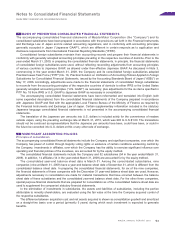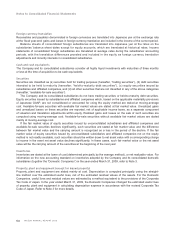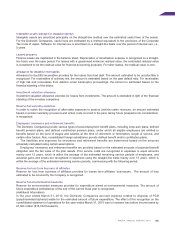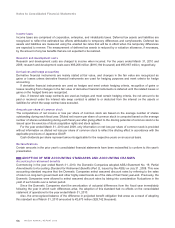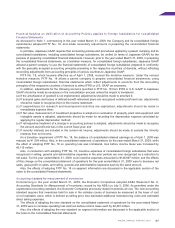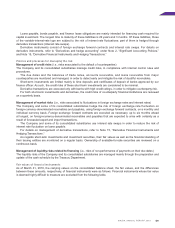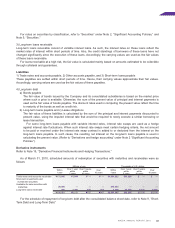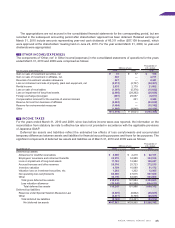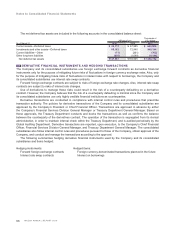Mazda 2010 Annual Report Download - page 58
Download and view the complete annual report
Please find page 58 of the 2010 Mazda annual report below. You can navigate through the pages in the report by either clicking on the pages listed below, or by using the keyword search tool below to find specific information within the annual report.
56
Income taxes
Income taxes are comprised of corporation, enterprise, and inhabitants taxes. Deferred tax assets and liabilities are
recognized to reflect the estimated tax effects attributable to temporary differences and carryforwards. Deferred tax
assets and liabilities are measured using the enacted tax rates that will be in effect when the temporary differences
are expected to reverse. The measurement of deferred tax assets is reduced by a valuation allowance, if necessary,
by the amount of any tax benefits that are not expected to be realized.
Research and development costs
Research and development costs are charged to income when incurred. For the years ended March 31, 2010 and
2009, research and development costs were ¥85,206 million ($916,194 thousand) and ¥95,967 million, respectively.
Derivatives and hedge accounting
Derivative financial instruments are mainly stated at fair value, and changes in the fair value are recognized as
gains or losses unless derivative financial instruments are used for hedging purposes and meet criteria for hedge
accounting.
If derivative financial instruments are used as hedges and meet certain hedging criteria, recognition of gains or
losses resulting from changes in the fair value of derivative financial instruments is deferred until the related losses or
gains on the hedged items are recognized.
Also, if interest rate swap contracts are used as hedges and meet certain hedging criteria, the net amount to be
paid or received under the interest rate swap contract is added to or deducted from the interest on the assets or
liabilities for which the swap contract was executed.
Amounts per share of common stock
The computations of net income or loss per share of common stock are based on the average number of shares
outstanding during each fiscal year. Diluted net income per share of common stock is computed based on the average
number of shares outstanding during each fiscal year after giving effect to the diluting potential of common stock to be
issued upon the exercise of stock acquisition rights and stock options.
For the year ended March 31, 2010 and 2009, only information on net loss per share of common stock is provided
without information on diluted net loss per share of common stock to reflect the diluting effect in accordance with the
applicable provisions of Japanese GAAP.
Cash dividends per share represent amounts applicable for the respective years on an accrual basis.
Reclassifications
Certain amounts in the prior year’s consolidated financial statements have been reclassified to conform to this year’s
presentation.
Accounting for retirement benefits
Commencing in the year ended March 31, 2010, the Domestic Companies adopted ASBJ Statement No. 19, Partial
Amendments to Accounting Standard for Retirement Benefits (Part 3), issued by the ASBJ on July 31, 2008. This new
accounting standard requires that the Domestic Companies select assumed discount rates by referring to the rates
of return on long-term government and other highly-rated bonds as of the date of their fiscal year-end. Previously, the
Domestic Companies were allowed to select assumed discount rates by taking into consideration fluctuations in the
yield of such bonds over a certain period.
Since the Domestic Companies start the amortization of actuarial differences from the fiscal year immediately
following the year in which such differences arise, the adoption of this standard had no effects on the consolidated
statement of operations for the year ended March 31, 2010.
Also, the unrecognized balance of the difference in projected benefit obligation that arose as a result of adopting
this standard as of March 31, 2010 amounted to ¥2,673 million ($28,742 thousand).




